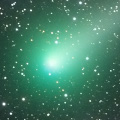
|
Now it is 6.5 mag (Oct. 13, Marco Goiato). It was expected to brighten up to 4-5 mag from autumn to winter. However, the brightness evolution has stopped in September. Now it is not observable. In the Northern Hemisphere, it will appear in the morning sky in late November, then it will be observable in excellent condition. In the Southern Hemisphere, it is hardly observable after this.
Date(TT) R.A. (2000) Decl. Delta r Elong. m1 Best Time(A, h)
Oct. 24 14 28.69 -28 29.9 1.808 0.927 19 6.4 19:52 ( 54, -1)
Oct. 31 14 26.51 -25 41.7 1.822 0.875 11 6.3 20:00 ( 50, -9)
|
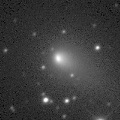
|
It brightened very rapidly. Now it is so bright as 9.3 mag (Oct. 22, Juan Jose Gonzalez). It is observable at 9-10 mag until next spring in excellent condition in the Northern Hemisphere. It keeps unobservable in the Southern Hemisphere.
Date(TT) R.A. (2000) Decl. Delta r Elong. m1 Best Time(A, h)
Oct. 24 16 17.16 80 8.5 1.871 2.172 93 9.6 19:52 (168,-34)
Oct. 31 16 19.99 76 34.1 1.872 2.152 92 9.5 20:00 (163,-35)
|
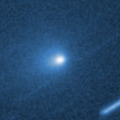
|
Now it is very bright as 9.5 mag (Oct. 14, Marco Goiato). In the Northern Hemisphere, it keeps very low in the evening until mid December. It will be getting lower gradually after this even in the Southern Hemisphere.
Date(TT) R.A. (2000) Decl. Delta r Elong. m1 Best Time(A, h)
Oct. 24 16 59.11 -21 36.6 2.078 1.558 45 10.9 19:52 ( 80, 24)
Oct. 31 17 21.86 -22 20.2 2.110 1.559 44 11.0 20:00 ( 77, 22)
|
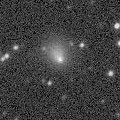
|
Now it is bright as 11.8 mag (Oct. 15, Juan Jose Gonzalez). It will pass close to the earth from spring to summer in 2016, and it is expected to be observable at 6-7 mag in good condition. In the Northern Hemispehre, it keeps observable in excellent condition until winter. In the Southern Hemisphere, it keeps very low until winter.
Date(TT) R.A. (2000) Decl. Delta r Elong. m1 Best Time(A, h)
Oct. 24 4 46.15 44 28.9 2.036 2.784 130 11.5 2:40 (180, 11)
Oct. 31 4 21.18 45 16.2 1.879 2.710 139 11.2 1:48 (180, 10)
|
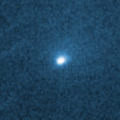
|
It brightened very rapidly. Now it is very bright as 11.1 mag (Oct. 9, Chris Wyatt). It keeps 11-13 mag until February. But it keeps very low in the Northern Hemisphere. It will be getting lower gradually after this even in the Southern Hemisphere.
Date(TT) R.A. (2000) Decl. Delta r Elong. m1 Best Time(A, h)
Oct. 24 17 33.83 -23 20.9 1.774 1.435 53 11.3 19:52 ( 82, 32)
Oct. 31 17 57.55 -24 18.4 1.794 1.426 52 11.3 20:00 ( 80, 30)
|

|
It brightened up to 3.7 mag and became a naked eye comet in mid January in 2015 (Jan. 13, Marek Biely). Now it is fading. But it is bright as 11.4 mag still now (Oct. 5, Katsumi Yoshimoto). In the Northern Hemisphere, it keeps observable for a long time until the comet fades out. It is not observable in the Southern Hemisphere.
Date(TT) R.A. (2000) Decl. Delta r Elong. m1 Best Time(A, h)
Oct. 24 16 40.90 27 58.9 4.142 3.693 56 12.0 19:52 (118, -8)
Oct. 31 16 48.50 26 34.3 4.255 3.764 54 12.2 20:00 (114,-13)
|
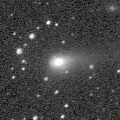
|
Now it is bright as 11.7 mag (Oct. 15, Juan Jose Gonzalez). It will be fading slowly after this. In the Northern Hemisphere, it keeps observable in good condition. In the Southern Hemisphere, it keeps low until November.
Date(TT) R.A. (2000) Decl. Delta r Elong. m1 Best Time(A, h)
Oct. 24 10 29.68 15 23.7 1.808 1.513 56 12.4 3:37 (247, 6)
Oct. 31 10 46.05 14 8.3 1.806 1.560 59 12.5 3:27 (247, 7)
|
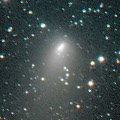
|
It brightened rapidly up to 10.4 mag from July to August (July 18, Maik Meyer). Now it is fading, but it is bright as 13.2 mag still now (Oct. 11, Seiichi Yoshida). It is observable in good condition in the Northern Hemisphere. It is not observable in the Southern Hemisphere.
Date(TT) R.A. (2000) Decl. Delta r Elong. m1 Best Time(A, h)
Oct. 24 19 32.53 46 4.0 1.548 1.911 94 13.5 19:52 (155, 2)
Oct. 31 19 46.90 46 13.3 1.610 1.958 94 13.8 20:00 (152, 0)
|

|
Now it is bright as 12.8 mag (Oct. 15, Juan Jose Gonzalez). It keeps 13 mag for a long time from 2015 autumn to 2016 summer. In the Northern Hemispehre, it keeps observable in good condition for a long time. It keeps unobservable in the Southern Hemisphere.
Date(TT) R.A. (2000) Decl. Delta r Elong. m1 Best Time(A, h)
Oct. 24 8 3.56 73 18.7 2.696 3.034 100 13.7 3:37 (190,-21)
Oct. 31 8 28.57 76 39.3 2.618 3.001 102 13.6 3:27 (189,-24)
|
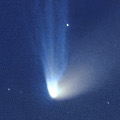
|
It approached to the sun down to 0.3 a.u. on July 6, and brighted up to 3.9 mag (July 6, Thomas Lehmann). Now it is fading. It has already faded down to 12.9 mag (Oct. 3, Chris Wyatt). In the Northern Hemisphere, it keeps observable until the comet fades out. It will not be observable after this in the Northern Hemisphere.
Date(TT) R.A. (2000) Decl. Delta r Elong. m1 Best Time(A, h)
Oct. 24 15 20.83 -51 0.4 2.860 2.245 43 13.7 19:52 ( 42, 21)
Oct. 31 15 40.64 -51 59.9 2.999 2.349 41 13.9 20:00 ( 39, 19)
|

|
Outburst occured on Sept. 22. It is bright as 12.5 mag still now (Oct. 4, Thomas Lehmann).
Date(TT) R.A. (2000) Decl. Delta r Elong. m1 Best Time(A, h)
Oct. 24 17 40.56 -28 48.8 6.498 5.996 55 13.9 19:52 ( 77, 35)
Oct. 31 17 45.49 -28 43.1 6.584 5.994 49 13.9 20:00 ( 74, 29)
|
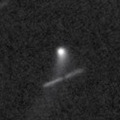
|
Now it is 15.1 mag (Sept. 13, Taras Prystavski). It will brighten up to 14 mag from 2015 to 2016. It keeps observable in good condition for a while.
Date(TT) R.A. (2000) Decl. Delta r Elong. m1 Best Time(A, h)
Oct. 24 1 30.52 15 0.9 3.210 4.200 173 14.3 23:19 (180, 40)
Oct. 31 1 17.54 15 3.8 3.239 4.206 165 14.3 22:39 (180, 40)
|
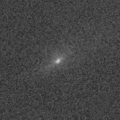
|
Now it is 14.2 mag (Oct. 11, Hidetaka Sato). In the Northern Hemisphere, it keeps observable after this while the comet will be fading. It is not observable in the Southern Hemisphere until January when the comet will fade down to 16 mag.
Date(TT) R.A. (2000) Decl. Delta r Elong. m1 Best Time(A, h)
Oct. 24 12 10.01 23 38.8 2.707 2.094 43 14.4 3:37 (254,-18)
Oct. 31 12 24.47 22 52.4 2.709 2.144 46 14.5 3:27 (254,-17)
|

|
Now it is 14.4 mag (Sept. 20, Yasukazu Ikari). Distant object, but it keeps observable at 14-15 mag for a long time from 2015 to 2016.
Date(TT) R.A. (2000) Decl. Delta r Elong. m1 Best Time(A, h)
Oct. 24 21 12.46 -6 59.4 4.730 5.127 108 14.5 19:52 (155, 60)
Oct. 31 21 14.60 -7 16.9 4.818 5.112 101 14.5 20:00 (141, 56)
|
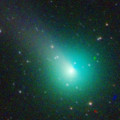
|
It brightened up to 6.0 mag in mid May (May 14, Chris Wyatt). Now it is fading. It has already faded down to 14.5 mag (Oct. 11, Seiichi Yoshida). In the Northern Hemisphere, it keeps observable in good condition after this while the comet will be fading. It locates somewhat low in the Southern Hemisphere.
Date(TT) R.A. (2000) Decl. Delta r Elong. m1 Best Time(A, h)
Oct. 24 8 29.34 25 22.5 2.454 2.593 86 14.6 3:37 (219, 18)
Oct. 31 8 22.24 26 53.5 2.398 2.681 95 14.7 3:27 (213, 20)
|

|
Appearing in the morning sky in the Northern Hemisphere. It will be observable after December in the Southern Hemisphere. It is expected to brighten up to 13 mag from winter to spring. It will be observable in excellent condition in the Southern Hemisphere. But it locates somewhat low in the Northern Hemisphere.
Date(TT) R.A. (2000) Decl. Delta r Elong. m1 Best Time(A, h)
Oct. 24 12 0.60 1 34.7 3.057 2.258 30 14.8 3:37 (271, -4)
Oct. 31 12 13.96 0 3.2 3.001 2.246 33 14.7 3:27 (272, -2)
|

|
It tends to brighten very rapidly around the perihelion passage. It will brighten up to 11 mag from November to December. It will appear in the evening sky in early December, then it will fade out very rapidly.
Date(TT) R.A. (2000) Decl. Delta r Elong. m1 Best Time(A, h)
Oct. 24 14 7.06 -14 14.5 1.839 0.851 4 15.7 19:52 ( 61,-13)
Oct. 31 14 39.71 -16 10.0 1.731 0.749 5 14.7 20:00 ( 59,-13)
|
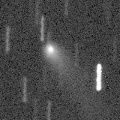
|
Now it is 14.4 mag (Sept. 13, Taras Prystavski). It keeps 15 mag for a long time from 2014 to 2015. It is observable in excellent condition in the Northern Hemisphere. It locates low in the Southern Hemisphere.
Date(TT) R.A. (2000) Decl. Delta r Elong. m1 Best Time(A, h)
Oct. 24 1 21.50 46 36.1 3.494 4.341 144 15.1 23:10 (180, 8)
Oct. 31 1 11.96 46 56.1 3.525 4.368 144 15.1 22:33 (180, 8)
|

|
First return of a periodic comet which brightened up to 8 mag in major outburst in 2010. It will be observable in excellent condition from winter to spring. Now it is not detected, fainter than 20 mag (Oct. 2, Jean-Francois Soulier).
Date(TT) R.A. (2000) Decl. Delta r Elong. m1 Best Time(A, h)
Oct. 24 8 24.70 30 23.0 1.697 1.950 88 15.7 3:37 (215, 15)
Oct. 31 8 40.24 30 1.8 1.598 1.915 92 15.1 3:27 (215, 15)
|
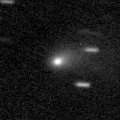
|
First return of a periodic comet discovered in 1994. It brightened up to 13.8 mag from summer to autumn (Sept. 7, Taras Prystavski). Now it is fading, but it is bright as 15.1 mag still now (Oct. 2, Katsumi Yoshimoto). It is observable in excellent condition in the Southern Hemisphere. It locates somewhat low in the Northern Hemisphere.
Date(TT) R.A. (2000) Decl. Delta r Elong. m1 Best Time(A, h)
Oct. 24 22 34.09 -27 46.8 1.817 2.448 118 15.1 20:24 (180, 83)
Oct. 31 22 36.84 -26 4.7 1.886 2.449 112 15.2 20:00 (179, 81)
|
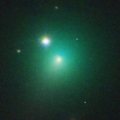
|
It is fading, but bright as 13.2 mag still now (Oct. 13, Katsumi Yoshimoto). It keeps observable in good condition until winter when the comet becomes fainter than 18 mag.
Date(TT) R.A. (2000) Decl. Delta r Elong. m1 Best Time(A, h)
Oct. 24 2 20.32 10 53.6 1.391 2.381 172 15.2 0:14 (180, 44)
Oct. 31 2 12.38 10 28.3 1.435 2.427 176 15.5 23:34 (180, 44)
|
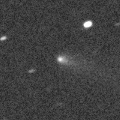
|
Now it is 14.6 mag (Sept. 18, Katsumi Yoshimoto). It keeps observable at 15 mag in good condition for a while.
Date(TT) R.A. (2000) Decl. Delta r Elong. m1 Best Time(A, h)
Oct. 24 2 25.60 5 17.8 1.135 2.121 169 15.2 0:19 (180, 50)
Oct. 31 2 21.64 4 37.8 1.140 2.126 170 15.3 23:43 (180, 50)
|

|
It will be observable at 14 mag from winter to summer. It will be observable in excellent condition in the Southern Hemisphere. It locates low in the Northern Hemisphere.
Date(TT) R.A. (2000) Decl. Delta r Elong. m1 Best Time(A, h)
Oct. 24 12 11.70 5 0.8 3.258 2.446 29 15.4 3:37 (270, -8)
Oct. 31 12 24.75 3 12.1 3.187 2.415 33 15.3 3:27 (271, -6)
|

|
Now it is 14.7 mag (Sept. 6, Sandor Szabo). In 2015, it keeps 13-14 mag and will be observable in good condition for a long time.
Date(TT) R.A. (2000) Decl. Delta r Elong. m1 Best Time(A, h)
Oct. 24 19 40.13 -14 38.7 3.884 3.913 84 15.5 19:52 (114, 52)
Oct. 31 19 46.56 -14 43.6 4.012 3.943 78 15.6 20:00 (107, 47)
|
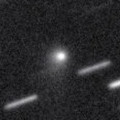
|
Now it is 14.9 mag (Sept. 13, Sandor Szabo). It keeps 15-16 mag for a long time until 2016. It keeps observable in excellent condition in the Northern Hemisphere. It keeps unobservable in the Southern Hemisphere.
Date(TT) R.A. (2000) Decl. Delta r Elong. m1 Best Time(A, h)
Oct. 24 5 33.38 66 50.2 4.706 5.187 113 15.5 3:27 (180,-12)
Oct. 31 5 28.19 68 20.8 4.651 5.188 117 15.5 2:55 (180,-13)
|
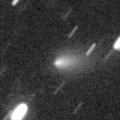
|
It was so faint as 20.0 mag in August (Aug. 17, Hidetaka Sato). However, it brightened by 6 mag in outburst in mid September. Now it is 15.6 mag (Oct. 2, Katsumi Yoshimoto). It keeps observable in excellent condition for a while.
Date(TT) R.A. (2000) Decl. Delta r Elong. m1 Best Time(A, h)
Oct. 24 4 50.89 2 17.4 1.394 2.210 134 15.6 2:44 (180, 53)
Oct. 31 4 46.73 1 8.9 1.392 2.253 141 15.8 2:12 (180, 54)
|
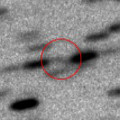
|
Now it is 18.0 mag (Sept. 24, Jean-Gabriel Bosch). It will brighten up to 11 mag from spring to summer in 2016. In the Northern Hemisphere, it keeps observable in good condition while the comet will be brightening. It locates somewhat low in the Southern Hemisphere.
Date(TT) R.A. (2000) Decl. Delta r Elong. m1 Best Time(A, h)
Oct. 24 6 4.72 19 44.8 2.219 2.836 118 15.9 3:37 (186, 35)
Oct. 31 6 5.80 19 38.3 2.099 2.796 125 15.6 3:27 (181, 35)
|
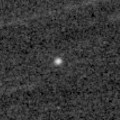
|
Now it is 16.7mag (Sept. 26, C. Bell). It is expected to brighten rapidly, and to be observable at 14.5 mag in good condition in autumn.
Date(TT) R.A. (2000) Decl. Delta r Elong. m1 Best Time(A, h)
Oct. 24 4 58.74 -9 25.3 0.669 1.509 129 15.9 2:51 (180, 64)
Oct. 31 5 5.36 -9 30.0 0.635 1.498 132 15.8 2:31 (180, 64)
|
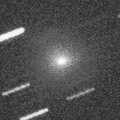
|
It brightened rapidly in mid August, and brightened up to 10.8 mag (Sept. 13, Sandor Szabo). Secondary component H also brightened up to 14.8 mag (Sept. 13, Thomas Lehmann). Now it is 13.1 mag (Oct. 13, Thomas Lehmann). It will fade out very rapidly after this. In the Northern Hemisphere, it keeps observable in good condition in the morning sky. In the Southern Hemisphere, it keeps locating extremely low from summer to autumn.
Date(TT) R.A. (2000) Decl. Delta r Elong. m1 Best Time(A, h)
Oct. 24 10 28.11 1 1.2 1.543 1.219 52 15.8 3:37 (258, 15)
Oct. 31 10 41.45 -1 15.7 1.576 1.297 55 16.5 3:27 (259, 17)
|

|
First return of a periodic comet discovered in 2003. Now it is 18.1 mag (Oct. 11, J.-F. Soulier). It will approach to the earth from autumn to winter, and it is expected to brighten up to 15 mag and observable in excellent condition. But actually, it is somewhat fainter than this ephemeris.
Date(TT) R.A. (2000) Decl. Delta r Elong. m1 Best Time(A, h)
Oct. 24 4 55.61 -5 50.3 0.898 1.724 131 16.1 2:48 (180, 61)
Oct. 31 4 58.47 -4 52.4 0.844 1.705 136 15.9 2:24 (180, 60)
|
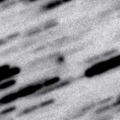
|
It brightened up to 16.4 mag in 2014 (Nov. 14, J. F. Hernandez). Now it is 17.2 mag (Aug. 27, D. Buczynski). It will be observable at 16 mag again from summer to autumn in 2015. However, it is fainter than this ephemeris recently.
Date(TT) R.A. (2000) Decl. Delta r Elong. m1 Best Time(A, h)
Oct. 24 4 21.48 28 27.2 1.786 2.635 141 16.1 2:15 (180, 27)
Oct. 31 4 17.16 28 17.0 1.763 2.663 148 16.1 1:43 (180, 27)
|
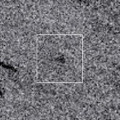
|
No observations have been reported after November in 2014. Current brightness is uncertain. It must keep 16 mag for a long time from 2015 autumn to 2016 summer. It keeps observable in excellent condition in the Southern Hemisphere. It locates low in the Northern Hemisphere.
Date(TT) R.A. (2000) Decl. Delta r Elong. m1 Best Time(A, h)
Oct. 24 0 56.89 -39 28.3 2.116 2.833 127 16.2 22:44 ( 0, 85)
Oct. 31 0 31.51 -41 8.9 2.176 2.804 119 16.2 21:52 ( 0, 84)
|

|
It brightened up to 13 mag in 2014. Now it is 15.2 mag (Sept. 12, Sandor Szabo). It will be fading slowly after this. It is observable at 16 mag in excellent condition from summer to winter in 2015.
Date(TT) R.A. (2000) Decl. Delta r Elong. m1 Best Time(A, h)
Oct. 24 1 10.71 -0 24.9 3.001 3.968 164 16.2 23:00 (180, 55)
Oct. 31 1 6.55 -0 36.3 3.050 3.983 157 16.2 22:28 (180, 56)
|

|
It brightened up to 11-12 mag in 2012. It has already faded down to 15.5 mag (May 11, Sandor Szabo). Appearing in the morning sky. It is observable at 16 mag in good condition from winter to spring.
Date(TT) R.A. (2000) Decl. Delta r Elong. m1 Best Time(A, h)
Oct. 24 11 15.72 -6 5.9 11.094 10.339 38 16.3 3:37 (271, 9)
Oct. 31 11 16.52 -6 18.1 11.050 10.377 45 16.3 3:27 (269, 13)
|

|
It brightened up to 6.9 mag in 2014 autumn (Oct. 17, Marco Goiato). Now it is fading. It has already faded down to 15.7 mag (Oct. 2, Katsumi Yoshimoto). In the Southern Hemisphere, it keeps observable in good condition until the comet fades out. In the Northern Hemisphere, it keeps observable until winter, but it locates somewhat low.
Date(TT) R.A. (2000) Decl. Delta r Elong. m1 Best Time(A, h)
Oct. 24 22 50.01 -28 52.1 4.765 5.338 120 16.5 20:40 (180, 84)
Oct. 31 22 45.25 -28 35.2 4.935 5.404 113 16.6 20:08 (180, 83)
|
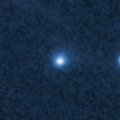
|
Now it is 16.8 mag (Sept. 20, Michael Jager). It will be fading after this. It will be fainter than 18 mag at the end of 2015.
Date(TT) R.A. (2000) Decl. Delta r Elong. m1 Best Time(A, h)
Oct. 24 23 27.31 -8 38.7 1.640 2.477 138 16.9 21:17 (180, 64)
Oct. 31 23 28.31 -8 34.3 1.703 2.481 132 16.9 20:51 (180, 63)
|
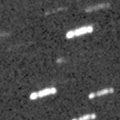
|
Now it is 16.5 mag (Sept. 24, J. V. Scotti). It is observable at 17 mag in excellent condition in autumn.
Date(TT) R.A. (2000) Decl. Delta r Elong. m1 Best Time(A, h)
Oct. 24 6 13.67 -0 19.7 1.148 1.798 113 16.9 3:37 (193, 55)
Oct. 31 6 18.56 -2 57.3 1.119 1.813 118 16.9 3:27 (188, 58)
|

|
Now it is 17.7 mag (Sept. 24, Jean-Gabriel Bosch). It will brighten up to 14 mag in 2016 summer. But it is not observable at the highlight. It keeps observable until March while the comet will be brightening gradually up to 15-16 mag.
Date(TT) R.A. (2000) Decl. Delta r Elong. m1 Best Time(A, h)
Oct. 24 0 24.08 -6 46.2 1.733 2.650 151 17.0 22:14 (180, 62)
Oct. 31 0 20.12 -7 17.3 1.752 2.620 143 16.9 21:42 (180, 62)
|
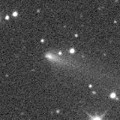
|
Now it is 15.5 mag (Sept. 20, Michael Jager). It keeps observable in good condition for a while. But it will be fading after this, and will be fainter than 18 mag in November.
Date(TT) R.A. (2000) Decl. Delta r Elong. m1 Best Time(A, h)
Oct. 24 0 1.19 -0 16.6 1.282 2.201 150 17.1 21:51 (180, 55)
Oct. 31 0 0.40 -0 32.6 1.363 2.236 142 17.4 21:23 (180, 55)
|
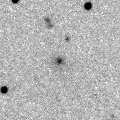
|
Now it is 15.8 mag (Sept. 18, Catalina Sky Survey). It keeps observable in good condition until the comet fades out. In 2014, it must have been observable at 14 mag in good condition in the Southern Hemisphere.
Date(TT) R.A. (2000) Decl. Delta r Elong. m1 Best Time(A, h)
Oct. 24 0 4.62 2 40.6 3.636 4.539 152 17.2 21:54 (180, 52)
Oct. 31 0 1.43 2 46.7 3.748 4.591 144 17.3 21:24 (180, 52)
|
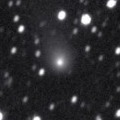
|
Now it is 15.5 mag (Sept. 6, Sandor Szabo). It is fading, but it is a bit brighter than this ephemeris. The fragments B and C are already fainter than 20 mag (June 12, Takaaki Oribe).
Date(TT) R.A. (2000) Decl. Delta r Elong. m1 Best Time(A, h)
Oct. 24 22 40.60 -1 45.4 5.983 6.674 130 17.3 20:31 (180, 57)
Oct. 31 22 38.12 -2 31.3 6.128 6.720 122 17.3 20:01 (180, 57)
|

|
Now it is 16.8 mag (Oct. 19, Hidetaka Sato). It keeps 16.5 mag for a long time in 2016, and it will be observable in excellent condition in the Southern Hemisphere. It is hardly observable in the Northern Hemisphere.
Date(TT) R.A. (2000) Decl. Delta r Elong. m1 Best Time(A, h)
Oct. 24 9 1.79 -41 50.7 4.062 3.826 69 17.4 3:37 (295, 51)
Oct. 31 8 59.62 -44 15.1 3.964 3.796 73 17.3 3:27 (299, 55)
|
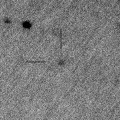
|
Now it is 18.8 mag (Sept. 24, A. Maury, J.-F. Soulier, T. Noel, J.-G. Bosch). Now it is near the aphelion. It is observable at 17 mag in good condition from autumn to winter.
Date(TT) R.A. (2000) Decl. Delta r Elong. m1 Best Time(A, h)
Oct. 24 3 46.60 16 13.1 3.408 4.310 151 17.4 1:40 (180, 39)
Oct. 31 3 42.80 16 4.0 3.357 4.301 159 17.3 1:09 (180, 39)
|
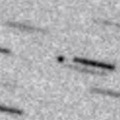
|
Now it is 16.3 mag (Sept. 27, E. Bryssinck). It is observable in good condition in the Northern Hemisphere. It is not observable in the Southern Hemisphere.
Date(TT) R.A. (2000) Decl. Delta r Elong. m1 Best Time(A, h)
Oct. 24 10 3.65 40 14.4 1.688 1.705 73 17.4 3:37 (224, -6)
Oct. 31 10 20.73 40 28.1 1.680 1.754 77 17.4 3:27 (224, -6)
|

|
Now it is 16.5 mag (Sept. 8, Jean-Francois Soulier). It has brightened in outburst up to 14 mag twice, in 2006 January and 2011 May. It is around the perihelion now. It keeps observable at 17 mag for a long time after this.
Date(TT) R.A. (2000) Decl. Delta r Elong. m1 Best Time(A, h)
Oct. 24 23 4.18 -5 49.3 5.140 5.884 134 17.4 20:54 (180, 61)
Oct. 31 23 3.49 -5 57.0 5.230 5.889 127 17.5 20:26 (180, 61)
|

|
First return of a periodic comet discovered in 1998. Now it is 17.9 mag (Oct. 3, J. V. Scotti). It will be observable at 17.5 mag from autumn to winter.
Date(TT) R.A. (2000) Decl. Delta r Elong. m1 Best Time(A, h)
Oct. 24 21 7.45 -15 27.4 1.466 1.969 104 17.6 19:52 (145, 67)
Oct. 31 21 14.29 -13 44.8 1.521 1.952 99 17.5 20:00 (134, 62)
|
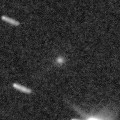
|
Now it is 16.7 mag (Sept. 19, J. Gonzalez). It was expected to brighten rapidly, and to be observable at 16 mag in good condition from summer to winter. But actually, it is much fainter than predicted.
Date(TT) R.A. (2000) Decl. Delta r Elong. m1 Best Time(A, h)
Oct. 24 22 31.11 -7 20.9 1.394 2.142 126 17.5 20:21 (180, 62)
Oct. 31 22 30.71 -6 7.1 1.436 2.116 120 17.5 20:00 (176, 61)
|
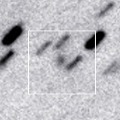
|
It keeps 17.5 mag for a long time from 2016 to 2019. It keeps locating near by the equator.
Date(TT) R.A. (2000) Decl. Delta r Elong. m1 Best Time(A, h)
Oct. 24 8 13.97 -0 11.6 10.337 10.290 84 17.7 3:37 (233, 41)
Oct. 31 8 14.99 -0 22.4 10.214 10.276 90 17.7 3:27 (229, 44)
|
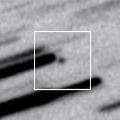
|
Now it is around the aphelion. It is observable at 17.5 mag in excellent condition in autumn in the Northern Hemisphere. It locates low in the Southern Hemisphere.
Date(TT) R.A. (2000) Decl. Delta r Elong. m1 Best Time(A, h)
Oct. 24 3 14.16 42 21.3 1.487 2.367 144 17.8 1:09 (180, 13)
Oct. 31 2 55.74 41 33.1 1.460 2.379 151 17.7 0:23 (180, 13)
|

|
It will pass the perihelion in 2019. However, it has not been brightening since the discovery in 2010. Now it is 17.9 mag (Sept. 11, E. Bryssinck). It keeps observable in excellent condition from autumn to next spring in the Northern Hemisphere. It is not observable in the Southern Hemisphere.
Date(TT) R.A. (2000) Decl. Delta r Elong. m1 Best Time(A, h)
Oct. 24 3 43.53 47 7.9 10.250 11.001 137 17.8 1:37 (180, 8)
Oct. 31 3 40.61 47 22.0 10.173 10.977 142 17.7 1:07 (180, 8)
|

|
Now it is 18.1 mag (Oct. 15, A. Maury, J.-F. Soulier, J.-G. Bosch, T. Noel). It is expected to brighten up to 13-14 mag in 2016 summer, and to be observable in excellent condition in the Southern Hemisphere. It is not observable at the high light in the Northern Hemisphere.
Date(TT) R.A. (2000) Decl. Delta r Elong. m1 Best Time(A, h)
Oct. 24 5 50.56 -0 1.8 2.600 3.210 119 18.1 3:37 (183, 55)
Oct. 31 5 46.15 -2 34.4 2.453 3.141 126 17.9 3:12 (180, 57)
|

|
Now it is 18.6 mag (Oct. 11, Hidetaka Sato). It is observable at 17 mag in good condition in winter.
Date(TT) R.A. (2000) Decl. Delta r Elong. m1 Best Time(A, h)
Oct. 24 7 52.34 11 58.2 2.179 2.430 92 18.0 3:37 (219, 34)
Oct. 31 7 59.91 11 58.0 2.083 2.419 97 17.9 3:27 (216, 35)
|

|
It was expected to approach to the earth down to 0.2 a.u. and brighten up to 15 mag from August to September. But actually, it is so faint as 19.5 mag, much fainter than predicted (Oct. 5, Hidetaka Sato).
Date(TT) R.A. (2000) Decl. Delta r Elong. m1 Best Time(A, h)
Oct. 24 22 44.45 5 27.5 0.558 1.436 133 21.5 20:36 (180, 49)
Oct. 31 23 0.74 5 54.5 0.649 1.499 130 21.9 20:24 (180, 49)
|
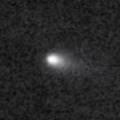
|
It brightened up to 15.9 mag in June as predicted (June 23, Ken-ichi Kadota). It was expected to be observable at 13 mag in good condition from summer to autumn. However, Jean-Gabriel Bosch detected the comet became disintegrating in July. Now it is so faint as 19.3 mag (Aug. 26, W. Hasubick). The fragment D and B are also observed as 19.0 mag (Sept. 20, Michael Jager) and 20.9 mag (Aug. 21, Pan-STARRS 1, Haleakala) respectively.
Date(TT) R.A. (2000) Decl. Delta r Elong. m1 Best Time(A, h)
Oct. 24 2 12.79 3 23.6 0.847 1.836 170 25.5 0:06 (180, 52)
Oct. 31 2 8.17 3 37.1 0.876 1.861 169 26.3 23:30 (180, 51)
|
|
![]()
 249P/LINEAR
249P/LINEAR C/2014 N3 ( NEOWISE )
C/2014 N3 ( NEOWISE ) P/2010 V1 ( Ikeya-Murakami )
P/2010 V1 ( Ikeya-Murakami ) 318P/2014 M6 ( McNaught-Hartley )
318P/2014 M6 ( McNaught-Hartley ) 88P/Howell
88P/Howell 61P/Shajn-Schaldach
61P/Shajn-Schaldach C/2014 Y1 ( PanSTARRS )
C/2014 Y1 ( PanSTARRS ) C/2012 F3 ( PanSTARRS )
C/2012 F3 ( PanSTARRS ) C/2013 V4 ( Catalina )
C/2013 V4 ( Catalina ) 205P/Giacobini
205P/Giacobini 81P/Wild 2
81P/Wild 2 230P/LINEAR
230P/LINEAR 141P/Machholz 2
141P/Machholz 2 329P/2015 T1 ( LINEAR-Catalina )
329P/2015 T1 ( LINEAR-Catalina ) 44P/Reinmuth 2
44P/Reinmuth 2 C/2014 W5 ( Lemmon-PanSTARRS )
C/2014 W5 ( Lemmon-PanSTARRS ) 117P/Helin-Roman-Alu 1
117P/Helin-Roman-Alu 1 C/2006 S3 ( LONEOS )
C/2006 S3 ( LONEOS ) C/2012 K1 ( PanSTARRS )
C/2012 K1 ( PanSTARRS ) 151P/Helin
151P/Helin P/2015 Q1 ( Scotti )
P/2015 Q1 ( Scotti ) 118P/Shoemaker-Levy 4
118P/Shoemaker-Levy 4 57P/du Toit-Neujmin-Delporte
57P/du Toit-Neujmin-Delporte C/2015 K1 ( MASTER )
C/2015 K1 ( MASTER ) C/2011 J2 ( LINEAR )
C/2011 J2 ( LINEAR ) C/2015 B2 ( PanSTARRS )
C/2015 B2 ( PanSTARRS ) 74P/Smirnova-Chernykh
74P/Smirnova-Chernykh 162P/Siding Spring
162P/Siding Spring 174P/(60558) 2000 EC98 ( Echeclus )
174P/(60558) 2000 EC98 ( Echeclus ) 328P/2015 S1 ( LONEOS-Tucker )
328P/2015 S1 ( LONEOS-Tucker ) 50P/Arend
50P/Arend C/2014 B1 ( Schwartz )
C/2014 B1 ( Schwartz ) (3200) Phaethon
(3200) Phaethon C/2010 U3 ( Boattini )
C/2010 U3 ( Boattini ) C/2015 T4 ( PanSTARRS )
C/2015 T4 ( PanSTARRS ) 211P/Hill
211P/Hill 320P/2015 HC10 ( McNaught )
320P/2015 HC10 ( McNaught ) 51P/Harrington
51P/Harrington![]()












































